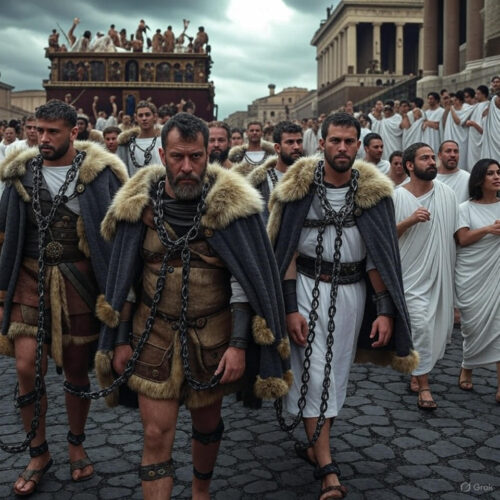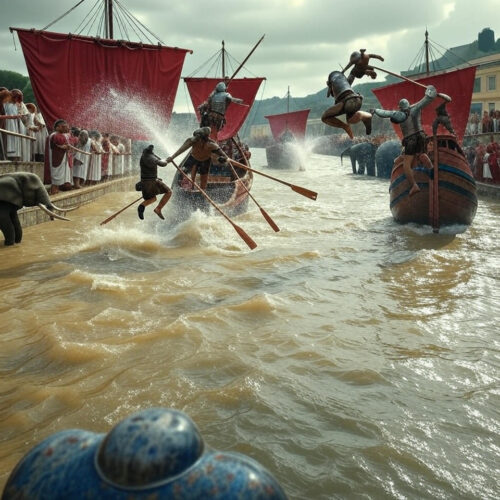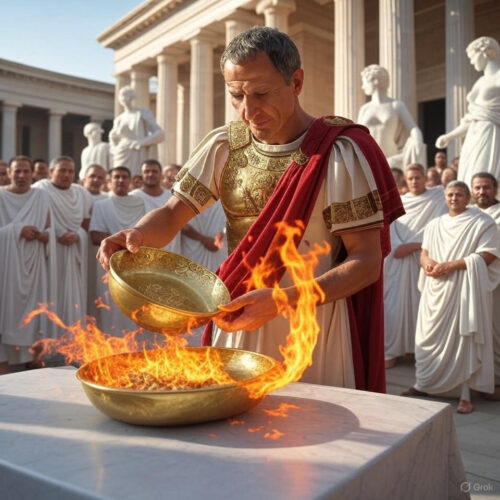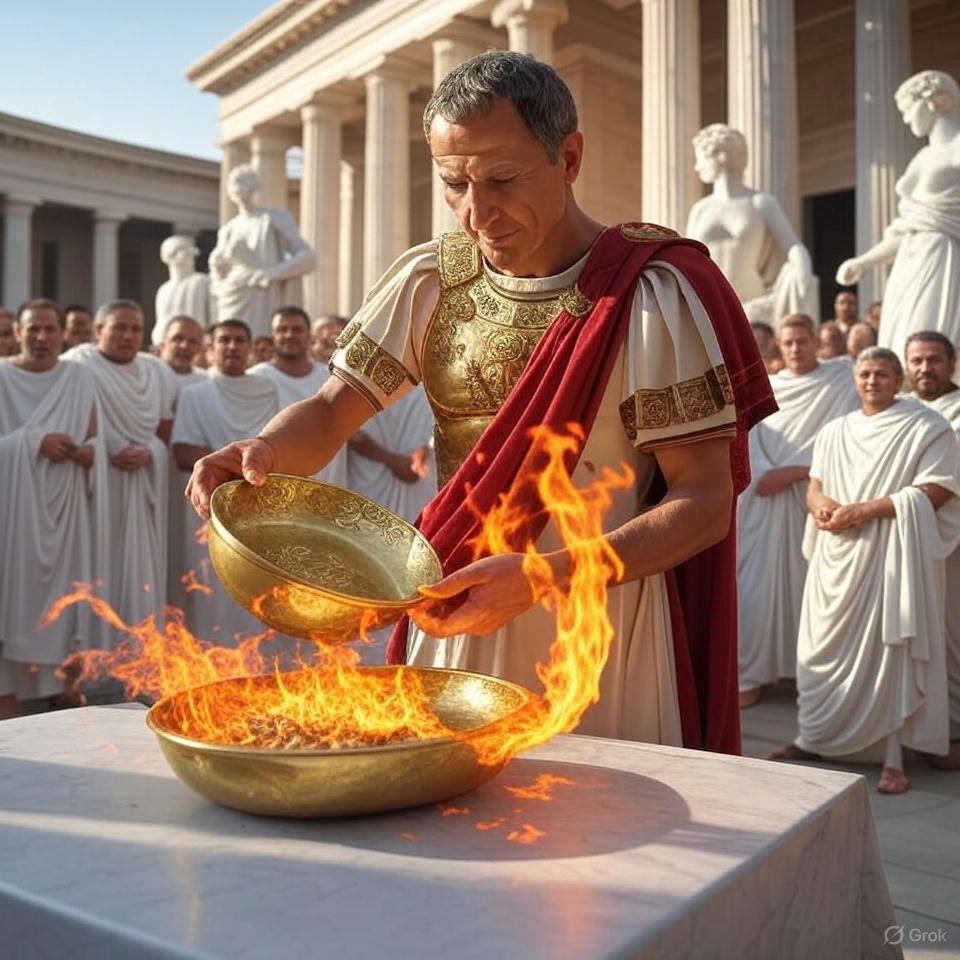Imagine a city pulsing with the roar of a million voices, the air thick with the scent of incense, garlands of laurel, and the metallic tang of freshly minted coins raining from chariots. Elephants trumpet in the distance, prisoners in chains trudge past jeering crowds, and towering floats depict epic battles frozen in wood and gold. This wasn’t some fever dream from a Hollywood epic— it was Rome on September 21, 46 BC, the day Julius Caesar kicked off his quadruple triumph, a celebration so lavish it redefined what it meant to be a conqueror. On this very date, two millennia ago, Caesar didn’t just parade his victories; he paraded the future of Rome itself. And while the empire eventually crumbled, the echoes of that day still whisper lessons on ambition, spectacle, and turning hard-won battles into lasting legacies. Buckle up, history buffs and self-starters alike— we’re diving deep into the dust, drama, and dazzling details of Caesar’s grand show, with a twist: how you can channel that triumphant energy to conquer your own daily grind.
### The Forge of a Titan: Caesar’s Road to the Triumphs
To understand the thunder of September 21, 46 BC, we have to backtrack through the blood-soaked tapestry of Julius Caesar’s rise. Born in 100 BC into the patrician Julii family— a clan claiming descent from the goddess Venus herself— young Gaius Julius was no silver-spooned slacker. Rome in the late Republic was a powder keg: corrupt senators hoarded power, the plebs starved in the streets, and generals like Marius and Sulla turned legions into personal armies, marching on the city like it was just another provincial town. Caesar, with his sharp tongue and sharper ambition, dodged Sulla’s proscription lists by growing his hair long and hiding in the Sabine hills, a teenage fugitive who would one day dictate the empire’s fate.
By his thirties, Caesar had whetted his appetite for glory as a military tribune and quaestor in Asia, where he earned the Corona Civica— the oak-leaf crown for saving a fellow Roman’s life in battle. But it was the 60s BC that catapulted him: allying with Pompey the Great and Crassus in the First Triumvirate, a shadowy pact that let Caesar snag the consulship in 59 BC. As consul, he pushed land reforms for veterans, married his daughter Julia to Pompey for glue, and then— oh, the real fun began— headed to Gaul as proconsul.
Gaul. That wild frontier of tribes, forests, and rivers teeming with Celts who saw Romans as just another flavor of invader. From 58 to 50 BC, Caesar waged what we’d now call total war, but back then it was “pacification.” He crossed the Rhine twice, terrifying Germanic tribes with bridge-building feats that engineers still geek out over. He invaded Britain in 55 and 54 BC, more PR stunt than conquest, but it stuck the landing for his rep. The big one? The siege of Alesia in 52 BC, where Vercingetorix, chieftain of the Arverni, rallied 80,000 Gauls against Caesar’s 60,000 Romans. Caesar encircled the hill fort with 11 miles of double fortifications— inner walls to trap the Gauls, outer to repel reinforcements. Starvation did the dirty work; Vercingetorix surrendered, and Gaul became a Roman breadbasket, funneling slaves, gold, and grain back to the Tiber.
But glory breeds enemies. Back in Rome, the Senate— led by Cato the Younger and Cicero’s pen— branded Caesar a butcher. When his term ended in 50 BC, Pompey, now Senate darling after Julia’s death soured the triumvirate, moved to strip Caesar’s command. Caesar’s response? “Alea iacta est”— the die is cast. On January 10, 49 BC, he crossed the Rubicon with the 13th Legion, sparking civil war. Pharsalus in 48 BC crushed Pompey; Egypt’s Ptolemaic court gifted him Cleopatra as a bonus (literally, rolled in a carpet). Then Pontus: Pharnaces II dared invade, but Caesar’s “Veni, vidi, vici” lightning campaign ended it in 47 BC. Africa capped it in 46 BC at Thapsus, where Optimates like Metellus Scipio and Cato fell— Cato ripping his guts out in Utica rather than live under Caesar.
By summer 46 BC, Caesar sailed home a god among men, his coffers stuffed, his legions loyal. Rome awaited not one triumph, but four— a quadruple first in history. And it all ignited on September 21.

### The Grand Parade Unfurls: Day One, The Gallic Glory
September 21, 46 BC. Dawn broke over a Rome scrubbed clean for the occasion— streets lined with captured marble from foreign quarries, altars smoking with sacrificial oxen. Caesar, ever the showman, timed the first triumph for the Gallic victory, saving the civil war bits for subtlety (or denial). A triumph wasn’t just a tickertape parade; it was ritual theater, sacred and savage, granted only by Senate vote for generals who’d slain 5,000+ foes in a foreign war.
The procession snaked from the Campus Martius, past the Circus Flaminius, up the Via Triumphalis to the Capitoline Hill. Leading? White oxen garlanded in gold, their horns gilded, throats soon slit on Jupiter’s altar. Then senators in togas, musicians blaring tibia flutes and cornua horns that echoed like war cries. Chariots groaned under spoils: torques of twisted gold from Gallic chieftains, shields bossed with Celtic knots, amphorae of wine from the Moselle vineyards now Roman.
Captives marched in chains— Gallic nobles with shaved heads and torcs, women and children from Alesia’s fall. Vercingetorix himself? He’d languined six years in a Roman dungeon; paraded now, his long hair a defiant mane, eyes burning with the Aedui fire. Behind them, floats— massive wagons like Hollywood sets. One showed the Rhine crossing: Caesar in a toga directing legionaries hammering pontoon bridges while Germans hurled spears from foggy banks. Another: Alesia’s siege, Gauls scaling double walls only to tumble into spike-filled ditches (lilia, Caesar called them— lilies of death).
Caesar rode the thalmus, a gold chariot drawn by white horses (though legend says he tripped on the reins, a bad omen he laughed off). Flanked by sons of slain Pompeians as pages— irony thick as Tiber mud— he wore the tunica picta, embroidered with stars, and the laurel crown hiding his balding pate. “Hail Caesar, the Unexpected God!” crowds chanted, per Suetonius, as florins showered like confetti.
The route hit the Forum, where Caesar dedicated the first installment to Venus Genetrix— his family’s patron, the “Mother of the Julii.” The temple, vowed at Pharsalus, gleamed new: marble from Carrara, pediment sculpted with Aeneas fleeing Troy. Inside, a Venus statue clutching Aeneas, flanked by trophies. But the real show? The Circus Maximus, packed for naumachia— a mock sea battle in an artificial lake, biremes clashing with 4,000 oarsmen reenacting Nile victories (spoiler: Egyptian “ships” sank spectacularly).
That night, banquets for 22,000 tables, per Pliny— Caesar footing the bill at 65,000 talents’ worth. Senators dined on peacock, plebs on roast boar; wine flowed from Gaul’s captured vines. Fun fact: Caesar’s generosity masked calculation— each soldier got 5,000 denarii (24,000 sesterces), centurions double, tribunes quadruple. Buy loyalty? Absolutely.
### Days of Dominion: Pontus, Egypt, and Africa Take the Stage
The quadruple wasn’t a one-off; it spanned 11 days, each a themed extravaganza. September 26 saw the Pontic triumph— “I came, I saw, I conquered” in wagon form. Floats depicted Zela’s rout: Pharnaces’ army fleeing as Caesar’s cavalry hacked through. Spoils? Pontic gold diadems, Mithridatic crowns melted for coin. Captives included Pharnaces’ kin, their Asian silks a splash of color against Roman white. Caesar, again on chariot, tossed coins scripted “Veni Vidi Vici,” the phrase blazed on a banner.
Egypt’s turn was scandalous spice. Inserted oddly between Gaul and Pontus (historians debate why— perhaps to bury civil war vibes), it paraded Nile spoils: obelisks (one still stands in Vatican Square), Ptolemaic gems, even hippos and crocs in cages (the crocs ate a spectator, says Cassius Dio). Arsinoe IV, Cleopatra’s sister-rival, chained and tear-streaked, led the captives— her Ptolemaic diadem a crown of thorns. Whispers rippled: Was that Cleopatra’s influence, parading her foe? The float? Actium’s precursor— Caesar’s legions storming Alexandria, Pothinus’ eunuch head on a pike (the real one, pickled).
Africa closed the show, October 2-ish. Thapsus’ ghosts marched: Juba I’s son, a toddler prince, in a tiny chariot; Metellus Scipio’s effigy stabbing itself (crowds groaned— too close to home). Wagons groaned with Numidian ivory, Libyan ostrich plumes, African lions prowling cages. One tableau: Cato’s Utica suicide, him eviscerating with a pen-knife, guts spilling like inked scrolls— artistic license, but it stung the Optimate holdouts.
Throughout, 20 massive paintings rolled: battles in oils, larger than life. No Pompey pics— tactful omission. Elephants (20 per side in combats) trumpeted; gladiators (1,000 foot, 200 horse per bout) spilled blood for fun. Musical contests, gymnastics— Caesar turned Rome into a month-long orgy of excess.

### Spectacles Beyond the Streets: Games, Gifts, and the Human Cost
Caesar didn’t stop at parades. The Circus Maximus hosted venationes— beast hunts with 400 lions, 600 Nemean bears (imported at ruinous cost). A naval battle in the flooded circus: 12-foot-deep water, quinqueremes ramming, marines boarding with hooks. “The water ran red,” Dio notes, though mostly stage blood.
Banquets? Epic. 22,000 couches for 66,000 diners; Caesar’s cooks roasted 1,000 ostriches, flooded cellars with Falernian. Poets recited— even lost works by Pacuvius. But under the glitter? Shadows. Vercingetorix strangled in the Tullianum prison post-parade. Arsinoe spared (Cleopatra’s mercy?), but resentment brewed. Senators muttered: Four triumphs? Hubris. The civil war pics? Salt in wounds for Pompey’s fans.
Sources paint vivid: Appian, eyewitness-ish via contemporaries, details the groans at Roman defeats depicted. Suetonius tallies spoils: 2,822 gold crowns, 65,000 talents (a talent? 6,000 denarii— enough for a legion’s pay). Pliny gripes the excess bankrupted provinces, but Caesar rebuilt: Forum Iulium, basilica, libraries. The Temple of Venus? Cornerstone, linking him to gods.
Fun aside: Caesar banned purple dye for non-royals (himself excepted), and his baldness? Laurel crowns covered it, birthing the “Caesar cut” joke.

### Echoes in Eternity: Aftermath and the Shadow of the Ides
The triumphs ended mid-October 46 BC, but ripples lasted. Caesar, Dictator Quartus (fourth term), reformed the calendar (Julian, anyone?), colonized veterans, drained marshes. Spain’s Munda in 45 BC nipped last resistance. But hubris? Assassins plotted. February 44 BC: Dictator Perpetuo. March 15: Knives in the Senate.
Significance? The quadruple triumph fused Republic ritual with imperial pomp, previewing Augustus’ model. It monetized glory— coins stamped with Caesar-Venus, circulating empire-wide. Culturally? “Triumph” entered lexicon for any big win. Politically? It alienated elites, proving spectacle can’t buy eternal love.
Historians debate scale: Appian says a million spectators; moderns peg 500,000— still Olympics-level. Cost? 100 million sesterces, per estimates— GDP chunk. Yet it worked: Caesar’s star burned brighter, his Julii line (via Octavian) birthed emperors.

### From Rubicon to Reflection: Unearthing the Timeless Spark
Now, fast-forward 2,072 years to today, September 21, 2025. Rome’s ruins stand as selfies backdrops, but Caesar’s playbook? Gold. The outcome of that 46 BC extravaganza wasn’t just parades— it was mastery of narrative. Caesar didn’t conquer lands; he conquered perceptions, turning chaos into legend. In a world of endless scrolls (er, feeds), where burnout lurks like Huns at the gates, his triumph teaches amplification: Small wins, scaled to inspire.
Sure, he fell to daggers, but the lesson endures— celebrate boldly to fuel the next charge. History’s meat is the marches and machinations; motivation’s the marrow. Here’s how that ancient blaze ignites your now:
– **Catalog Your Conquests**: Like Caesar’s floats, list your “Gauls”— projects crushed, habits slain. Specific: Track three quarterly wins in a journal, sketching them as vignettes (e.g., “The Deadline Siege: Me vs. Q4 Report, victory via midnight coffee ramparts”).
– **Dedicate to a Deity (or Drive)**: Venus Genetrix was Caesar’s anchor; pick yours— family, passion, growth. Bullet: On win-days, donate 10% of “spoils” (bonus? Time?) to it, like temple gold.
– **Parade with Purpose**: Skip humblebrags; host micro-triumphs. Idea: Quarterly “Caesar Night”— invite allies, share war stories over feast, award toy laurels for roles played.
– **Spoils for the Squad**: Caesar’s denarii bought loyalty; divvy your gains. Tactic: Post-victory, gift team shoutouts or small tokens— a coffee run echoes legion pay.
– **Guard the Omen**: Triumphs tempt hubris; Caesar tripped but rose. Practice: After highs, journal “shadow risks”— what envy or error lurks? Counter with one humility act, like crediting a mentor publicly.
**Your Personal Triumph Plan: A 5-Step March to Glory**
- **Scout the Field (Prep Week)**: Audit battles ahead— career pivot, fitness overhaul. Map “enemies” (doubts, distractions). Gather “spoils” symbols: medals, notes.
- **Cross Your Rubicon (Victory Push)**: Commit— deadline it. Channel Caesar: Daily “Veni” mantra. Track progress like dispatches to HQ.
- **Launch the Procession (Celebration Day)**: Pick a date (your Sep 21). Route: Home altar to feast table. Invite 3-5 “senators.” Share tales, visuals.
- **Distribute the Laurels (Sustain)**: Allocate rewards— self-treat, shares. Dedicate: Write vow to higher goal, like Caesar’s temple.
- **March Onward (Legacy Loop)**: Reflect: What fueled? Adjust for next. Quarterly repeat, building empire of momentum.
Caesar’s day reminds: Life’s no straight legion line— it’s triumphs amid tumults. Embrace the parade; the gods (and gains) favor the bold.


